Red eyes are actually fairly common in birds and particularly so across many species of birds found in North America. Most of them tend to be water birds, or birds who inhabit areas near some kind of water, but there are a range of birds, including backyard birds, with red-eyes that are certainly worth your attention!
This article will determine the most common and widespread birds in North America that have red eyes. They vary in appearance and behaviour but spotting them is a generally easy task. With some species, you may need to be within close range to identify the redness in their eyes, however, each bird has other identifiable qualities that can help you with your birdwatching endeavors.
Let’s take a look at the red-eyed birds found in North America. They are certainly ones you would want to keep an eye out for!
1. Cooper’s Hawk
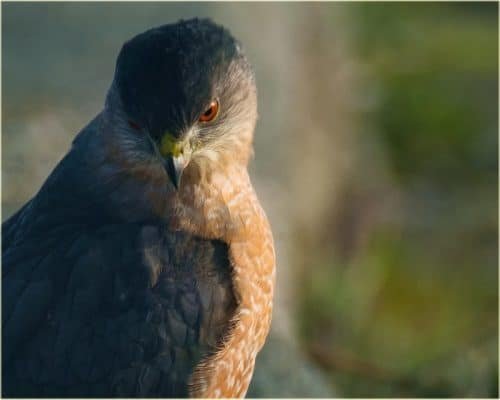
These mighty creatures are unmistakable. Their eyes redden and darken from an orange tone as they transition from juveniles to adults, resulting in two red daggers spotted easily at a distance.
These hawks can be regularly seen in many North American forests, ranging across most of the land. They have deep black crowns and backs and contrasting brown-white breasts.
Not only are they attractive birds, but they are also strong and powerful flyers. Cooper’s Hawks have short but stiff wings and long tails, enabling them to fly at great speed through dense forestry. They can be rather hostile and will likely feed on small birds, much to the frustration of backyard birders as these hawks often visit backyard feeders in search of finches and sparrows.
To learn more about Cooper’s Hawk you can visit: https://www.audubon.org/field-guide/bird/coopers-hawk
2. Western Grebe
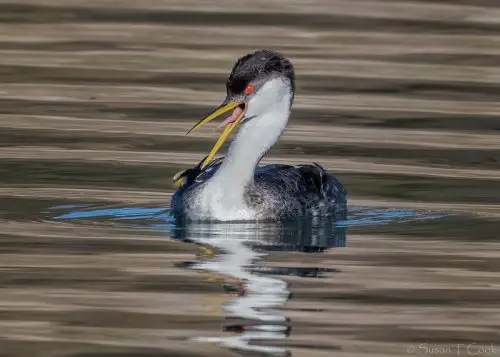
One of many red-eye Grebes in this list is the Western Grebes. These birds are large bodied with notable long necks and bills.
Their bodies are mostly grey, but they have dark, black heads that shade their red eyes. Some Western Grebes have a distinct, white dot near their eyes too. Like many others in this list, these Grebes are water-based creatures, breeding in marshes and ponds as well as on the ocean in wintertime.
They are often mistaken for the Clark’s Grebe, detailed later in the article, however there are primary differences between the two to help make a distinction.
Firstly, Western Grebes are far more widespread across the U.S. when they appear in flocks. They are also darker than the Clark’s and have a yellow-green tinge on their bills.
To learn more about Western Grebe you can visit: https://www.audubon.org/field-guide/bird/western-grebe
3. White-winged Dove
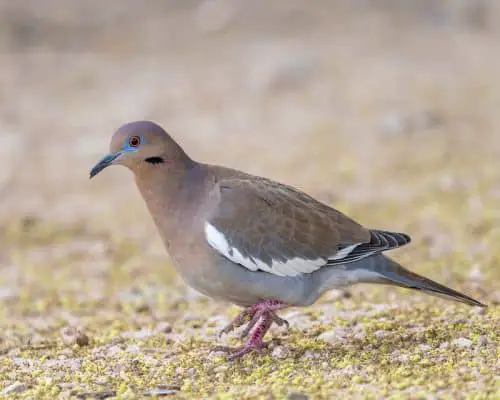
These birds are large pigeons with notable namesake white wings that differentiate them from other pigeons and doves.
Their bodies are similar to that of a robin, rather short and plump and unintimidating. As well as bright red eyes, they also have large blue eye rings due to bare patches of skin showing through their feathers.
Their bodies are generally a brownish-grey colour and their faces more brownish with black patches on each cheek. Although these birds were primarily attributed to the dry deserts of the Southwest U.S., they have more recently been found in other towns and cities in the more northern regions of North America.
These doves are regular visitors to backyard bird baths and feeders and generally eat seeds and grass, as well as berries when they are available near trees. White-winged Doves are frequently found in large flocks travelling together in one direction.
To learn more about White-winged Dove you can visit: https://www.audubon.org/field-guide/bird/white-winged-dove
4. American Coot
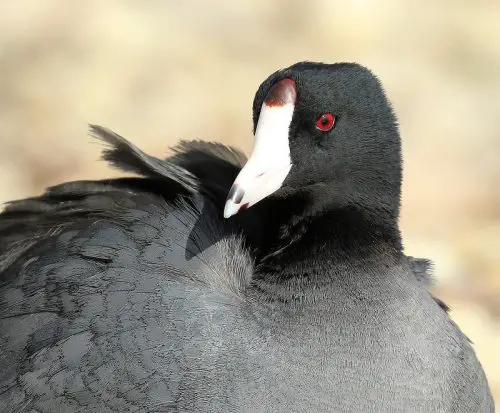
Whilst many water-based birds have red eyes, an American Coot is likely to stand out. They are extremely unique-looking, and are in fact the red-eyed birds you are most likely to spot in the U.S.
This coot is a black bird that is often mistaken for a duck, with a unique chicken-like bill that is a bright white pigment.
They tend to have green legs and feet with rather peculiar and easily identifiable lumps on each toe. Their large feet can also be seen in flight, which is indeed unique and rare. American Coots inhabit many water-based areas, particularly ponds and small lakes in most of the U.S. and Canada. For this reason, they are commonly found in parks and highly populated areas, and can be heard by their loud, aggressive calls.
Non-breeding seasons sees them migrating southwards, sometimes even into South America.
To learn more about American Coot you can visit: https://www.audubon.org/field-guide/bird/american-coot
5. Spotted Towhee
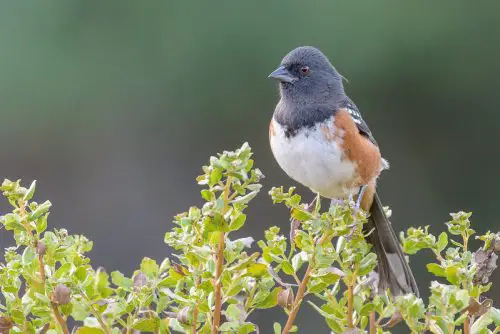
These eager, red-eyed birds are large sparrows with black bodies and reddish bellies. They are often mistaken with the Eastern Towhee, and they were actually considered the same species until fairly recently.
Their difference, however, primarily comes from the Spotted Towhee’s loud song that can be heard from thick, dense shrubbery where these birds prefer to reside.
They are often spotted in the Western regions of the U.S. and Canada, most commonly seen hopping on the ground and through leaf piles. As well as piercing red eyes, they also have stark white spots on their lengthy wings, which helps them fly long distances.
To learn more about Spotted Towhee you can visit: https://www.audubon.org/field-guide/bird/spotted-towhee
6. Killdeer
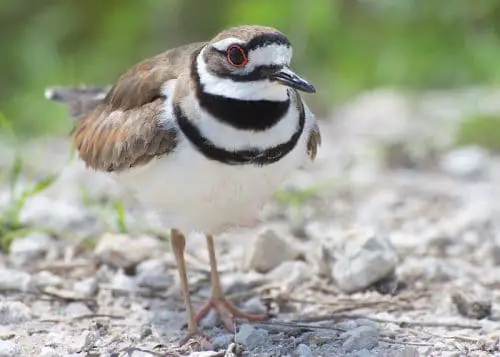
Killdeers have remarkably unique eye details. Their eyes are in fact a brownish shade, but they have reddened skin around each eye forming prominent red eye rings.
Interestingly, these eye rings are affected by breeding seasons and turn vibrant in colour (as is also the case with other shorebirds). Killdeers are regular birds of much of the North American shores. They are, however, also found in fields, parks, yards and several other urban locations.
As well as unique eye details, these birds also have a peculiar striped pattern on their heads and upper bodies. They are black, brown and white in detail and are petite birds (no larger than the size of a robin), which are often found hopping on the ground foraging.
To learn more about Killdeers you can visit: https://www.audubon.org/field-guide/bird/killdeer
7. Common Loon
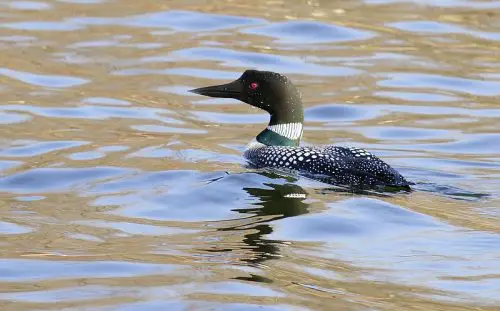
In the quieter regions of the Northern U.S. and Canada, near lakes, ponds and other freshwater surfaces, you might come across a Common Loon.
These are large-bodied, diving birds with short, almost invisible tails. Their bodies generally appear flat, especially during flight and they have long, sharp bills resting on rounded faces. Their colouring is heavily dependent on the changing of the season, appearing a rich black colour with white detailing in summer and much paler and greyer during winter.
They are extremely peaceful birds that prefer the solitude of quiet, open areas. Generally, they do not react well to disturbances brought on by humans and people who walk past.
To learn more about Common Loon you can visit: https://www.audubon.org/field-guide/bird/common-loon
8. Red-eyed Vireo
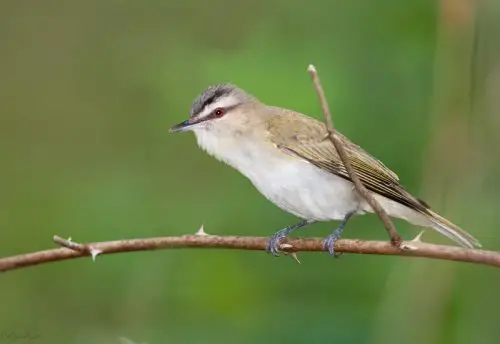
The appropriately named Red-Eyed Vireo is truly a remarkable bird. As they are the only bird in North America with mention of their red eyes in their name, they have a lot to live up to in their appearance. And they truly do not disappoint.
These birds are attractive, confident songbirds with green bodies and stark red eyes. They are in fact, amongst the most prominent species of birds in the U.S., despite not actually being seen or spotted that often.
This is partly due to the fact that they inhabit high, dense trees in moist landscapes. They do, however, have an unmistakable song that can be heard and recognised on hot summer afternoon in the absence of other songbirds.
Red-Eyed Vireos eat many tree insects like caterpillars, and inn non-breeding seasons, these birds migrate towards the Amazon in search of other insects to forage.
To learn more about Red-eyed Vireo you can visit: https://www.audubon.org/field-guide/bird/red-eyed-vireo
9. Wood Duck

Wood Ducks are colourful birds that are known for their blood orange eyes and deep red eye rings. These waterfowls are a renowned display of colours, with emerald green bodies and red-brown plumages.
They can be found across much of North America near quieter water-based areas.
In summer, they tend to reside in warm ponds and swamps, and in winter they can be spotted in streams, flooded areas and lakes too. These birds tend to nest in holes in trees near water surfaces and have thick, sturdy claws to enable them to climb tree bark.
Wood Ducks are broadly seen in the U.S. and their vibrant colour make for an easy and remarkable sighting.
To learn more about Wood Duck you can visit: https://www.audubon.org/field-guide/bird/wood-duck
10. Phainopepla
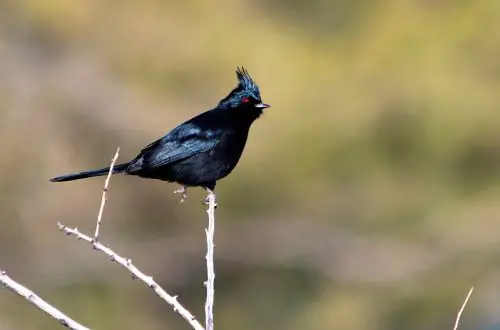
One of the most unique birds in this list is the Phainopepla. These birds are swift flycatchers with prominent dark red eyes and patchy, white wings that can be seen in flight from great distances.
Phainopeplas are common to the deserts of Southwest regions of U.S. as well as Mexico.
Their silky black feathers on their bodies contrast greatly with the desert landscape, making for an easy sighting. They are built similar to a robin in size and can be seen feeding on berries and insects, particularly where there is mistletoe and oak forestry.
These birds are extremely territorial and perch for extensive periods of time in search of danger or intruders. They will also form numerous flocks whilst nesting and breeding to ward off potential threats.
To learn more about Phainopepla you can visit: https://www.audubon.org/field-guide/bird/phainopepla
11. Cinnamon Teal
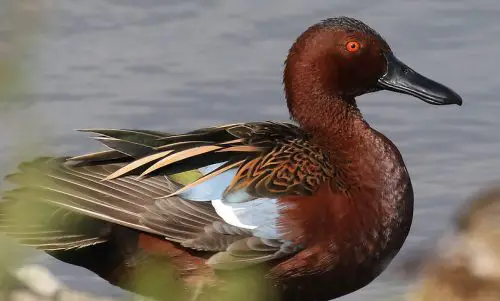
In breeding seasons, you may well find these Cinnamon Teals near water in much of the U.S. and Canada. They can be easily identified by their namesake rich, cinnamon-brown colour and flaming red eyes.
These birds also have distinguishable black bills and dark brown backs and can be found gliding slowly across water beds such as ponds.
Cinnamon Teals are petite ducks that inhabit reservoirs, swamps, ponds and other freshwater surfaces. In nonbreeding seasons, these birds are likely to migrate into Mexico.
To learn more about Cinnamon Teal you can visit: https://www.audubon.org/field-guide/bird/cinnamon-teal
12. Black-crowned Night-Heron
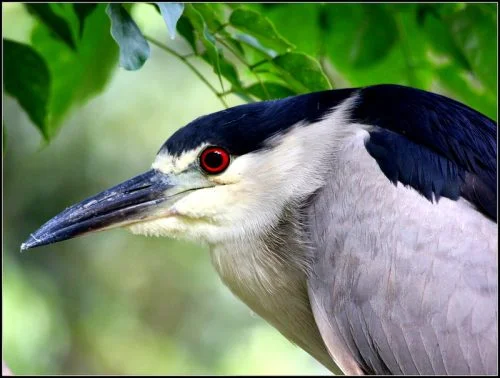
Night-Herons are given their name as they typically forage at night, mostly in and around shallow water beds. They are not likely to be active during the day and tend to rest or hide, making it somewhat difficult to get a sighting of one.
These birds usually nest in dense wooded and bushy areas near water, together in small flocks. They are, however, magnificent birds with rich brown bodies streaked in white and grey and have crowns painted in a rich black shade.
Adults have red eyes, as do most water-based birds, that cannot be missed. They are stocky birds, measuring larger than a crow.
To learn more about Black-crowned Night-Heron you can visit: https://www.audubon.org/field-guide/bird/black-crowned-night-heron
13. Yellow-crowned Night-Heron
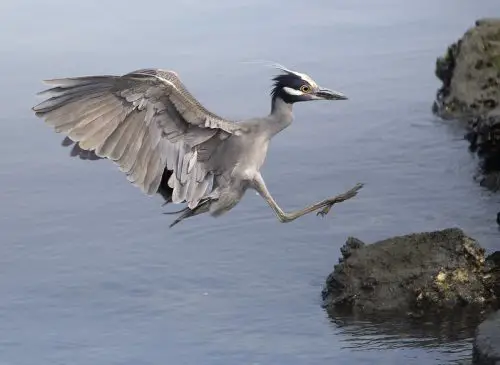
Killdeers have remarkably unique eye details. Their eyes are in fact a brownish shade, but they have reddened skin around each eye forming prominent red eye rings.
Interestingly, these eye rings are affected by breeding seasons and turn vibrant in colour (as is also the case with other shorebirds). Killdeers are regular birds of much of the North American shores. They are, however, also found in fields, parks, yards and several other urban locations.
As well as unique eye details, these birds also have a peculiar striped pattern on their heads and upper bodies. They are black, brown and white in detail and are petite birds (no larger than the size of a robin), which are often found hopping on the ground foraging.
To learn more about Yellow-crowned Night-Heron you can visit: https://www.audubon.org/field-guide/bird/yellow-crowned-night-heron
14. Sharp-shinned Hawk
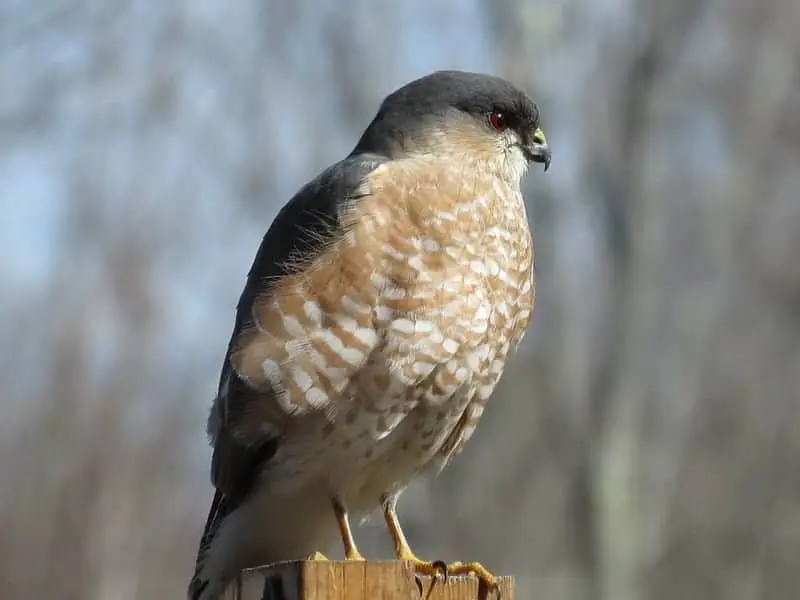
This particular type of hawk is small with short, stocky wings and a petite head. These birds are known for their long tails, detailed with streaks of dark colours running down the feathers.
The rest of their bodies are mostly a blue-grey colour, apart from prominent blood orange bars on either side of the breasts and razor red eyes. Despite their short wings, these birds are indeed skilful fliers that can hold great speed and dive down through narrow and dense woodlands.
They feed on small songbirds, often surprising them in attach from low perches and hiding along shrubbery. These hawks breed deep in dense forestry, although they can be spotted in open areas and open skies most summers in the U.S. In non-breeding seasons these birds are their most secretive, hunting prey from bushes and sometimes even attacking at backyard bird feeders.
To learn more about Sharp-shinned Hawk you can visit: https://www.audubon.org/field-guide/bird/sharp-shinned-hawk
15. Canvasback
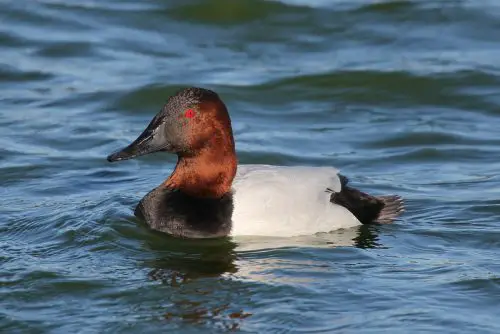
One of the most common ducks to have red eyes is the Canvasback duck. Male Canvasbacks are known to have staggering red eyes, whilst females have much browner and duller eyes.
These ducks are curious, diving creatures, measuring at about a mid-way point between a crow and a goose.
They have identifiable large, brown heads with ruffles white feathers and deep black plumages.
As Canvasbacks are diving ducks, they spend much of their time near lakes and deep ponds and can be attributed to coastal parts of Southern U.S. during breeding seasons. Like many other birds, in winter they might migrate towards Mexico although some stay local to the U.S.
To learn more about Canvasback you can visit: https://www.audubon.org/field-guide/bird/canvasback
16. Eastern Towhee
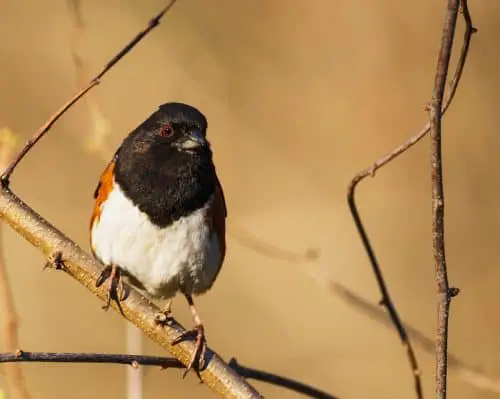
A counterpart to the Spotted Towhee is the Eastern Towhee, which are found accordingly in the Eastern regions of the U.S. unlike the more Western-bound Spotted Towhee.
Despite being confused with the Spotted Towhee, these birds have white panels on their wings, not spots. These birds are black and rouged, with prominent white spots on their tails.
These birds also have notable red eyes that complement the rusty colour of their sides and underbellies.
Although they can be hard to spot amongst the shrubbery and bushes in which they choose to inhabit, they can also be drawn rather easily to sunflower seed feeders.
To learn more about Eastern Towhee you can visit: https://www.audubon.org/field-guide/bird/eastern-towhee
17. Horned Grebe
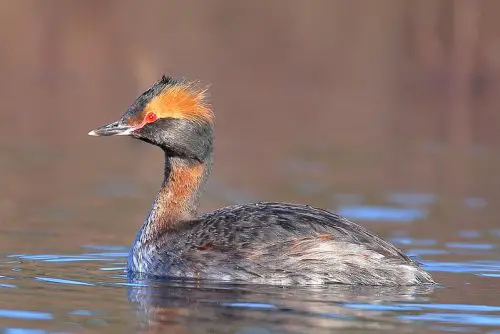
Whilst several species of grebes have red eyes, such as the black and white Western and Clark’s, the Horned Grebe is the most widespread in North America.
They are most commonly attributed to Canada and Alaska, but migration may take them to the U.S. where they nest in and around ponds and lakes. In winter in particular, these birds sought after the U.S. coastlines, or anywhere where freshwater remains tepid and available year-round. As creatures of water, they forage mainly for small fish and insects that live near water surfaces.
They are rather small compared to the average water bird, with red and brown bodies and black heads with visible stripes of orange and yellow painted across. Their thin, stretched bills aid them in foraging in water and their piercing red eyes are intimidating to possible intruders.
To learn more about Horned Grebe you can visit: https://www.audubon.org/field-guide/bird/horned-grebe
18. White-tailed Kite
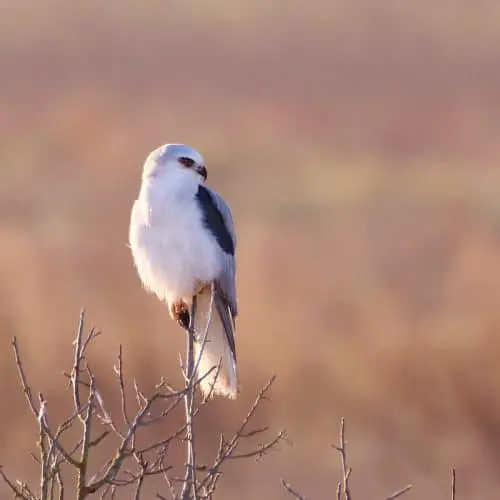
Another red-eyed bird is the White-tailed Kite, known for its stark white tail and deep black shoulder patches. Their red eyes are staggering and stand out against their white head feathers.
These birds are large raptors with thin, narrow tails and sharp wings.
Their wings allow them to glide rapidly against wind and hover discretely before diving down to feed on small animals.
They can be found primarily in grasslands and woodlands, as well as any other field or generally open areas across much of the U.S. White-tailed Kites can appear to be very intimidating birds, but they are truly a sight to see.
To learn more about White-tailed Kite you can visit: https://www.audubon.org/field-guide/bird/white-tailed-kite
19. Eared Grebe
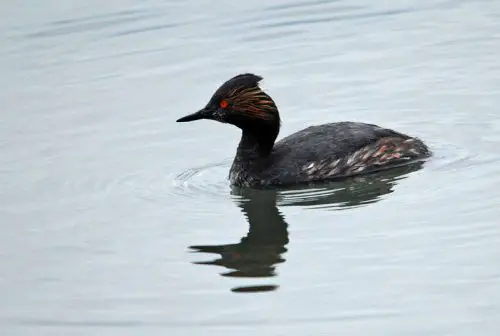
Eared Grebes are no exception to other red-eyed Grebes in this list. Their eyes, although only really visible at a close range, are truly piercing.
The rest of their bodies are otherwise duller in colour, altering with the seasons. In summer, they bare black feathers with flakes of golden brown across their cheeks and extending down onto the necks in patches.
Winter sees their pigment dull a little, as they are generally greyer with a darker crown.
They are relatively small birds, compared to the average Grebe, with prominent thin and sharp bills that aids them in foraging in ponds and lakes. The Eared Grebe is often compared with the Horned Grebe in appearance and behaviour, although the Eared Grebes are noticeably far smaller, especially in the head and neck. They inhabit much of North America’s freshwater landscape in the summer, often attributed to open ocean waters in winter, too.
To learn more about Eared Grebe you can visit: https://www.audubon.org/field-guide/bird/eared-grebe
20. Black Rail
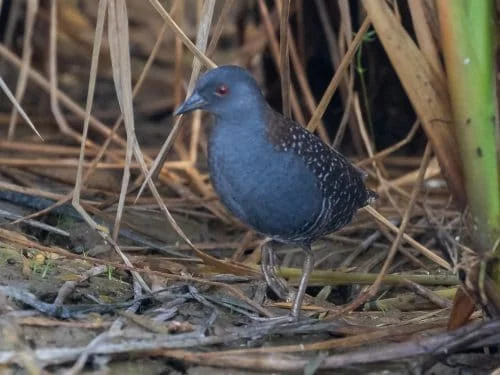
This tiny bird is very difficult to spot. Black Rails are about the size of a sparrow and have grey-brown bodies that conceal them against shrubbery and bushes.
Their red eyes are very vibrant, however, if seen up close. They also have white patches along their wings that may help with identification.
Black Rails are, however, relatively rare bird, making a sighting of one unlikely unless dealt with great patience and persistence.
It is likely that these birds are heard, rather than seen as they have a distinct song that is vocalised regularly throughout the night.
They typically reside near freshwater and often saltwater marshes near large shrubbery. If you do happen to catch a glimpse of this bird, it will indeed be an unforgettable experience.
To learn more about Black Rail you can visit: https://www.audubon.org/field-guide/bird/black-rail
21. Red-breasted Merganser
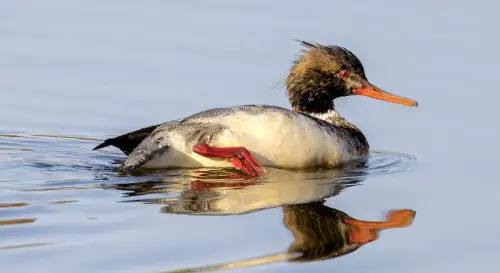
Another diving duck in this list is the Red-breasted Merganser, an aquatic bird common to many regions of North America.
These birds have particularly large bodies and are thinner than many other water-based ducks. Their necks are long and prominent, along with their bills that extend far and narrow to help them forage in the wetlands. These Mergansers have odd, shaggy green head feathers which give them a truly distinctive look.
Males also have a cinnamon-brown chest and white necks that extend up to their green heads. Females, however, tend to be much browner and duller in colour and as a result may be more difficult to identify.
Both males and females, however, are easier to identify whilst they are flying, as they bare bright, white feathers on their wings. As they are water-based creatures, they can be found primarily near fresh wetlands and saltwater coastal regions.
To learn more about Red-breasted Merganser you can visit: https://www.audubon.org/field-guide/bird/red-breasted-merganser
22. Clark’s Grebe
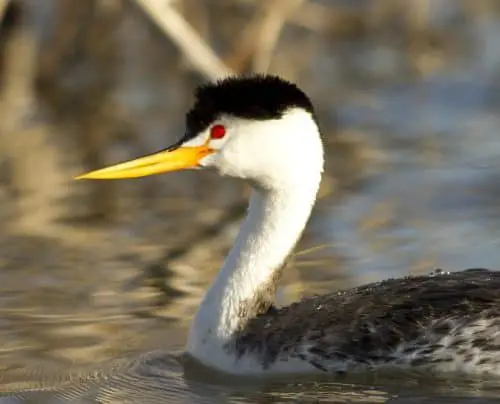
Another water-based red-eyed bird is the Clark’s Grebe. Often found in saltwater bays in winter and freshwater ponds in summer, these birds are very common to much of the U.S.
They are, in fact, very similar to the Western Grebe, sharing qualities such as long, extended necks and narrow bills. Their faces are white, which emphasises the red in their eyes.
These Grebes aren’t as widespread as the Western Grebes and appear generally paler in colour (except for their bills which stand out with a bright orange colour).
To learn more about Clark’s Grebe you can visit: https://www.audubon.org/field-guide/bird/clarks-grebe
23. Yellow-green Vireo
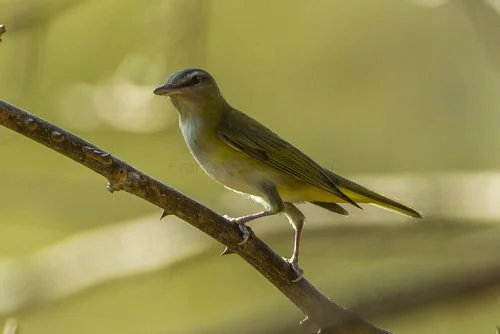
Often confused with the highly similar Red-eyed Vireo, these birds are also fairly widespread birds with red eyes, albeit primarily in the Southern states into Mexico and Central America.
Yellow-green Vireos are primarily tropical creatures, breeding in tropical forests in warm climates, but they can often be seen in Southern U.S. during hot summer days as well.
These are particularly large compared to other Vireos, with wide and bulky bills and very vocal, loud songs. They are mostly bright green in colour, with several flakes of yellow on each side.
Yellow-green Vireos are arguably amongst some of the most visually stunning red-eyed birds in this list, which makes the sight of one truly remarkable.
To learn more about Yellow-green Vireo you can visit: https://www.audubon.org/field-guide/bird/yellow-green-vireo
